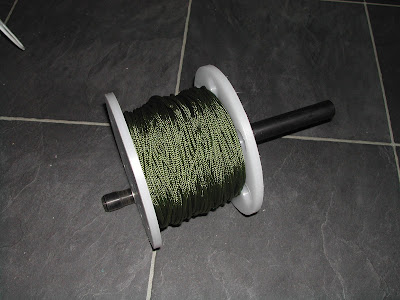Having waited some time to get the new yak on the water for some serious paddling, the oppertunity came with a weekend on the North East coast. Saturday saw a few friends and myself out of North bay at Scarborough, the weather was rain with a slight wind and the sea had about a foot of swell so nothing that could not be handled.
Once out on the water I soon got used to the tippy feel of the yak and settled in to paddling. The yak moved through the water with ease which I expected but I was really suprised by how it tracked keeping a straight line even with cross wind, having spent the last couple of years paddling the Big Game and fighting the slightest breeze to keep straight, this yak was a pleasure.
After 20 mins or so, we decided to put a bit of recovery practice in, so I capsized the yak and took the plunge.
On starting my self recovery I was amazed at how the yak came to meet me, with the gunwale below the waterline it made recovery very easy, the only thing needing any thought was how not to go straight over the other side. The narrow beam means that weight shifting suddenly from one side to the other needed to be done with a bit of agile presision, something I`ve grown out of over the years but the riding a bike theory applies to yaking and I managed to stay upright.
After a couple of re-entries we got back to paddling and ventured further from the beach, paddling into the wind, across it and then with it, the yak was behaving itself nicely but it didn`t seem challenging enough so I started a bit of messing about. I flipped over the side and made my way round to the bow, I intended mounting the yak from the bow just to see if it could be done, well maybe on a mill pond with an acrobat but not me, not today. First attempt and I was straight back in, second go and I managed to get up on the bow deck and sat for about 5 seconds, bump from a wave and the sea had got me back in, leave that for another day I thought.
Having seen the pictures taken on the day, courtesy of Andy Elliot, the Malachite seems to be sat a bit low in the water suggesting that my 13 stone may just be a little short of its load carrying ability, if I were to compare it to other s.o.t`s, that may be the case, looking at the first picture with Dave`s sit in sea kayak, both seem to be at the same level so I`m not to concerned. A future test of load carrying will have to take place.
The Sunday of the weekend saw us launch at Flamborough`s North landing. Now this isn`t a place for the faint hearted, the slip is enough to bust your lungs when you are pulling your yak back up.
The forcast was looking good and the weather was perfect. We made our way down the slip and launched on to a calm sea, paddled out of the cove and into a wind of about 5mph, we were heading into the wind and up towards Bempton cliffs. I had put on the thigh straps today, these were supplied with the yak and what a difference they made. Control of the craft was much improved and they also allowed me to deliver more power to my paddle stroke, I will keep them on the yak from now on.
Arriving under Bempton we decided to do a spot of fishing, now the comfort of the BG was begining to be missed. I prefer to fish side saddle, the malachite does not lend itself to this very easily, I felt very vulnerable and decided that for the time being, sat in the seat with my legs over each side was the safer option. Having spent an hour fishing without any sign of fish, we decided to head back down the coast and try our luck near the landing, I stowed my gear and off we went.
I stopped along the way and beached my yak at the bottom of the cliffs on the rocks, by this time the sea had got up a bit and there were 2/3ft waves breaking. I noticed Dave was heading towards me in his Dorado, he took one look at the shore line and promptly turned back out to sea. Definately one advantage poly yaks have over glass yaks is you can beach on rocks.
Once we reached the landing the others carried on with their fishing while I carried on getting to know my yak.
I`ve enjoyed my first couple of days afloat on the Malachite and look forward to many more outings and more new experiences.
A New Start !
-
So, am I still fishing?, well in all honestly no. I endured a turbulent
three years of a divorce, finally escaping a year ago. My previous partner
kille...
2 months ago










